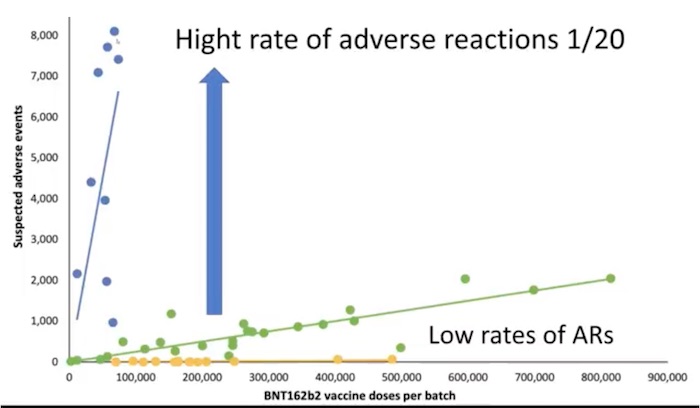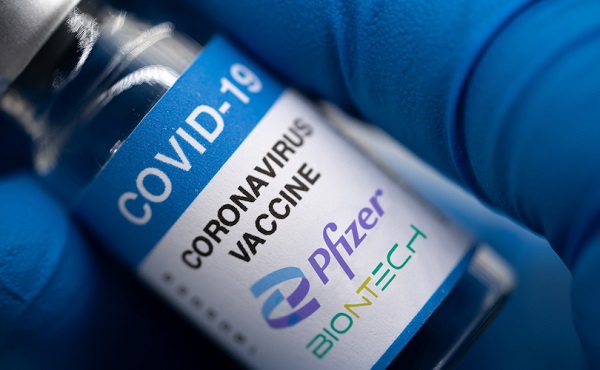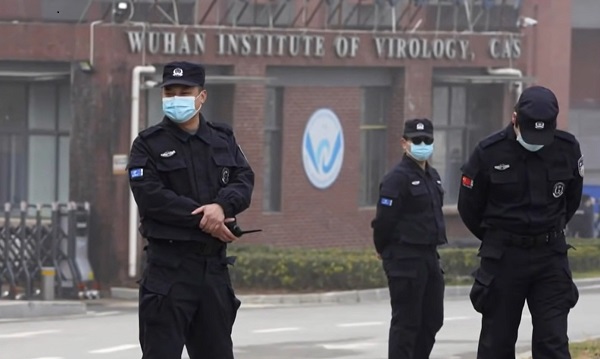COVID-19
71% of reported adverse reactions to COVID-19 vaccine from just 4.2% of vaccine batches: Danish study

From Dr. John Campbell on YouTube
A report “Batch-dependent safety of the BNT162b2 mRNA COVID-19 vaccine” by Danish researchers Max Schmeling, Vibeke Manniche, Peter Riis Hansen is shedding light on the number of adverse reactions to specific batches of the Pfizer-BioNTech’s COVID-19 vaccines.
The researchers note in their report
“Vaccine vials with individual doses are supplied in batches with stringent quality control to ensure batch and dose uniformity.2 Clinical data on individual vaccine batch levels have not been reported and batch-dependent variation in the clinical efficacy and safety of authorized vaccines would appear to be highly unlikely. However, not least in view of the emergency use market authorization and rapid implementation of large-scale vaccination programs, the possibility of batch-dependent variation appears worthy of investigation. We therefore examined rates of SAEs between different BNT162b2 vaccine batches administered in Denmark (population 5.8 million) from 27 December 2020 to 11 January 2022.”
The results of the study are astounding. In certain vaccine batches reported adverse reactions occurred in one out of every twenty shots. Other batches have yet to be associated with any adverse reactions at all. As British health researcher Dr. John Campbell explains, this study could pose very serious questions Pfizer must address.
Viral Vaccine paper
Dr. Campbell’s presentation notes:
Batch-dependent safety of the BNT162b2 mRNA COVID-19 vaccine
https://onlinelibrary.wiley.com/doi/1…
71% of the suspected adverse reactions occurred in 4.2% of the vaccine batches
Numbers of suspected adverse events (SAEs), after BNT612b2 mRNA vaccination in Denmark.
27 December 2020–11 January 2022, (population 5.8 million)
(According to the number of doses per vaccine batch)
Each dot represents a single vaccine batch.
By 11 November 2022 (European area) 701 million doses of Pfizer given 971,021 reports of suspected adverse effects (SAEs)
Clinical data on individual vaccine batch levels have not been reported (batch-dependent variation in the clinical efficacy and safety of authorized vaccines would appear to be highly unlikely)
We therefore examined rates of SAEs between different BNT162b2 vaccine batches administered in Denmark
Data on all SAE cases, Danish Medical Agency (DKMA) SAE seriousness was classified as non-serious, serious (hospitalization or prolongation of existing hospitalization, life-threatening illness, permanent disability or congenital malformation) or SAE-related d****
Anonymized data SAEs were counted on a batch level by linking individual SAEs to the batch label(s) of BNT162b dose(s)
10,793,766 doses administered 4,026,575 persons 52 different BNT162b2 vaccine batches (2,340–814,320 doses per batch)
43,496 SAEs were registered in 13,635 persons 61,847 batch-identifiable SAEs, of which 14,509 (23.5%) were classified as severe, 579 (0.9%) were SAE-related d*****
Unexpectedly Rates of SAEs per 1000 doses varied considerably between vaccine batches
From 1 SAE per 20 doses given to I in many thousands to zero
Variabilities
Vaccine manufacturing
Storage
Transportation
Clinical handling and control
Administration technique
Viral vaccine paper, Dr Vibeke Manniche
COVID-19
Major new studies link COVID shots to kidney disease, respiratory problems

From LifeSiteNews
Receiving four or more COVID shots was associated with 559% higher likelihood of cold in children, a new study found, and another one linked the shots to higher risk of renal dysfunction.
Two major new studies have been published sounding the alarm about the COVID-19 shots potentially carrying risks of not only respiratory diseases but even kidney injury.
The Washington Stand first drew attention to the studies, published in the International Journal of Infectious Diseases (IJID) and International Journal of Medical Science (IJMS), respectively.
The first examined insurance claims and vaccination records for the entire population of South Korea, filtering out cases of infection prior to the start of the outbreak for a pool of more than 39 million people. It reported that the COVID shots correlated with mixed impacts on other respiratory conditions. A “temporary decline followed by a resurgence of URI [upper respiratory infections] and common cold was observed during and after the COVID-19 pandemic,” it concluded. “In the Post-pandemic period (January 2023–September 2024), the risk of URI and common cold increased with higher COVID-19 vaccine doses,” it noted.
Children in particular, who are known to face the lowest risk from COVID itself, had dramatically higher odds of adverse events the more shots they took. Receiving four or more was associated with 559% higher likelihood of cold, 91% higher likelihood of pneumonia, 83% higher likelihood of URI, and 35% higher likelihood of tuberculosis.
The second study examined records of 2.9 million American adults, half of whom received at least one COVID shot and half of whom did not.
“COVID-19 vaccination was associated with a higher risk of subsequent renal dysfunction, including AKI [acute kidney injury] and dialysis treatment,” it found, citing 15,809 cases versus 11,081. “The cumulative incidence of renal dysfunction was significantly higher in vaccinated than in unvaccinated patients […] At the one-year follow-up, the number of deaths among vaccinated individuals was 7,693, while the number of deaths among unvaccinated individuals was 7,364.” Notably, the study did not find a difference in the “type of COVID-19 vaccine administered.”
The researchers note that this is not simply a matter of correlation, but that a causal mechanism for such results has already been indicated.
“Prior studies have indicated that COVID-19 vaccines can damage several tissues,” they explain.
“The main pathophysiological mechanism of COVID-19 vaccine-related complications involve vascular disruption. COVID-19 vaccination can induce inflammation through interleukins and the nod-like receptor family pyrin domain-containing 3, an inflammatory biomarker. In another study, thrombosis episodes were observed in patients who received different COVID-19 vaccines. Additionally, mRNA COVID-19 vaccines have been associated with the development of myocarditis and related complications […] The development of renal dysfunction can be affected by several biochemical factors [26]. In turn, AKI can increase systemic inflammation and impair the vasculature and red blood cell aggregation. Given that the mechanism underlying COVID-19 vaccine-related complications corresponds to the pathophysiology of kidney disease, we hypothesized that COVID-19 vaccination may cause renal dysfunction, which was supported by the results of this study.”
Launched in the final year of President Donald Trump’s first term in response to COVID-19, Operation Warp Speed (OWS) had the COVID shots ready for use in a fraction of the time any previous vaccine had ever been developed and tested. As LifeSiteNews has extensively covered, a body of evidence steadily accumulated over the following years that they failed to prevent transmission and, more importantly, carried severe risks of their own. COVID was a sticking point for many in Trump’s base, yet he doggedly refused to disavow OWS.
Since leaving office, Trump repeatedly promoted the shots as “one of the greatest achievements of mankind.” The negative reception to such comments got him to drop the subject for a while, but in July 2022, he complained that “we did so much in terms of therapeutics and a word that I’m not allowed to mention. But I’m still proud of that word, because we did that in nine months, and it was supposed to take five years to 12 years. Nobody else could have done it. But I’m not mentioning it in front of my people.”
So far, Trump’s second administration has rolled back several recommendations for the shots but not yet pulled them from the market, despite hiring several vocal critics of the COVID establishment and putting the Department of Health & Human Services under the leadership of America’s most prominent anti-vaccine activist, Robert F. Kennedy Jr. Most recently, the administration has settled on leaving the current vaccines optional but not supporting work to develop successors.
In early August, Kennedy announced the government would be “winding down” almost $500 million worth of mRNA vaccine projects and rejecting future exploration of the technology in favor of more conventional vaccines. Last week, HHS revoked emergency use authorizations (EUA) for the COVID shots, which were used to justify the long-since-rescinded mandates and sidestep other procedural hurdles, and in its place issued “marketing authorization” for those who meet a minimum risk threshold for the following mRNA vaccines: Moderna (6+ months), Pfizer (5+), and Novavax (12+).
“These vaccines are available for all patients who choose them after consulting with their doctors,” Kennedy said, making good on his pledge to “end COVID vaccine mandates, keep vaccines available to people who want them, especially the vulnerable, demand placebo-controlled trials from companies,” and “end the emergency.”
COVID-19
Spy Agencies Cozied Up To Wuhan Virologist Before Lying About Pandemic


From the Daily Caller News Foundation
By Emily Kopp
The Office of the Director of National Intelligence’s (ODNI) hub for foreign biological threats dismissed the intelligence pointing to a lab accident in Wuhan as “misinformation” in January 2021, two former government sources who requested anonymity to discuss sensitive internal meetings told the Daily Caller News Foundation. New documents show that intelligence risked implicating ODNI’s own bioengineering advisor — University of North Carolina professor Ralph Baric.
Baric, who engineered novel coronaviruses with the Wuhan Institute of Virology (WIV), advised ODNI four times a year on biological threats, according to documents released Oct. 30 by Kentucky Sen. Rand Paul.
Dear Readers:
As a nonprofit, we are dependent on the generosity of our readers. \
Please consider making a small donation of any amount here.
Thank you!
Baric did not respond to the DCNF’s requests for comment.
The professor’s ties to American intelligence may run even deeper, the documents reveal, as ODNI facilitated a meeting between the CIA and Baric about a project on coronaviruses in September 2015.
The email exchange with the subject line “Request for Your Expertise” shows an unnamed government official with a CIA-affiliated email address pitching a “possible project” to Baric relating to “[c]oronavirus evolution and possible natural human adaptation.”
The new documents shed a bit of light on a question members of Congress have posed for years: Whether our own intelligence agencies knew more about the likelihood of a lab origin of COVID than they told the public.
“Director Ratcliffe has been on the forefront of this issue since the start of the COVID-19 pandemic and has been committed to transparency and accountability on this issue,” a CIA spokesperson said in a statement. “In January – as one of the Director’s first actions at Langley – CIA made public its assessment that a research-related origin of the COVID-19 pandemic is more likely than a natural origin. CIA will continue to evaluate any available credible new intelligence reporting as appropriate.”
Paul is seeking more documents from ODNI on potential ties between U.S. intelligence and the research in Wuhan as part of an ongoing investigation by the Senate Committee on Homeland Security and Governmental Affairs and has promised public hearings in the coming months.
Director of National Intelligence (DNI) Tulsi Gabbard disbanded the ODNI biological threats office earlier this year following questions from the DCNF about its suppression of COVID origins intelligence in August. Gabbard and a dedicated working group have also been quietly investigating the origins of COVID.
Protecting Their Own

Baric gave a presentation to the ODNI in January 2020 showing that he advised American intelligence that COVID may have emerged from a lab, the documents also indicate. Baric shared that the WIV had sequenced thousands of SARS-like coronaviruses, including strains capable of epidemics, the slides show.

Baric noted that the Wuhan lab does this work under low biosafety levels despite the ability of some of these viruses to infect and grow in human lung cells.
What Baric omitted: He had submitted a grant application in 2018 with intentions to conduct research to make coronaviruses with the same rare features seen in COVID while concealing the Wuhan lab’s low biosafety level, jotting in the margins of a draft of the grant application that Americans would “freak out” if they knew about the shoddy standards.
One year after Baric’s presentation, ODNI had hardened against the lab leak hypothesis.
When State Department officials pushed to declassify certain intelligence related to a plausible lab leak in January 2021, the ODNI expressed concerns that it would “call out actions that we ourselves are doing.”
Former ODNI National Counterproliferation and Biosecurity Center (NCBC) Director Kathryn Brinsfield, a medical doctor, also dismissed a January 2021 presentation by government officials about a plausible lab origin of COVID as “misinformation,” two sources told the DCNF. Her top aide Zach Bernstein, who possesses a master’s degree in security studies but no scientific credentials, also dismissed the presentation, according to three sources.
Gabbard disbanded NCBC in August following questions from the DCNF about its role in suppressing COVID origins intelligence.
But in the years preceding Gabbard’s takeover of the intelligence community’s central office, the ODNI’s public reports omitted any analysis of COVID’s viral genome. One intelligence agency filed a formal complaint about this glaring omission, the DCNF reported.
Scientists often received fierce pushback from former National Intelligence Council official Adrienne Keen, who helped steward former President Joe Biden’s 90-day review into COVID’s origins, an official told the DCNF. Paul’s request for records from ODNI includes a request for some of Keen’s communications.
Brinsfield and Keen did not respond to requests for comment.
Unanswered Questions
Despite the new disclosures, the precise nature of the CIA’s interest in Baric’s coronavirus work remains unknown. The documents do not include any further details about the work that the CIA and Baric may or may not have undertaken.
The U.S. Agency for International Development (USAID) funded the discovery of novel coronaviruses and shipped the samples to Wuhan through a 2009-2020 program called PREDICT, the DCNF reported in July. USAID sometimes acted as a CIA front before Trump dismantled it earlier this year — but no evidence exists that the CIA directed PREDICT.
An unnamed FBI special agent was in communication with Baric about responding to public requests for his research and emails with the Wuhan lab through the North Carolina Freedom of Information Act, according to a 2024 congressional letter, but details about the contact between the FBI and Baric also remain uncertain.
The CIA was slow to acknowledge that a lab was the pandemic’s most likely source, an assessment that the CIA made public more than five years after the pandemic emerged and well after the FBI and the Department of Energy.
In early 2020, when Trump’s Deputy National Security Advisor Matt Pottinger tasked CIA analysts to dig into the matter, they came up empty, according to a New York Times report. Instead, anonymous sources smeared Pottinger as having a “conspiratorial view” of the Chinese Communist Party.
Trump’s current CIA Director John Ratcliffe, who served as the DNI from May 2020 to January 2021, revealed in a 2023 Wall Street Journal op-ed that he had pushed for the declassification of COVID origins intelligence as the DNI but that he “faced constant opposition, particularly from Langley.”
-

 Energy1 day ago
Energy1 day agoIt should not take a crisis for Canada to develop the resources that make people and communities thrive.
-

 Fraser Institute2 days ago
Fraser Institute2 days agoCourts and governments caused B.C.’s property crisis—they’re not about to fix it
-

 Alberta1 day ago
Alberta1 day agoFederal budget: It’s not easy being green
-

 Alberta2 days ago
Alberta2 days agoChatGPT may explain why gap between report card grades and standardized test scores is getting bigger
-

 Education2 days ago
Education2 days agoJohns Hopkins University Announces Free Tuition For Most Students
-

 Business2 days ago
Business2 days agoParliamentary Budget Officer begs Carney to cut back on spending
-

 Business1 day ago
Business1 day agoWill Paramount turn the tide of legacy media and entertainment?
-

 Energy1 day ago
Energy1 day agoA picture is worth a thousand spreadsheets



